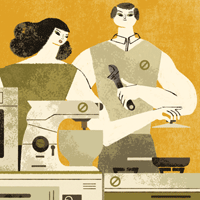Buying equipment isn’t what it used to be. The dealer landscape has shifted with the times and the economy. And, as with any industry upheaval, strong players get stronger and independents get creative.
The shift began in the last few years when the dealer/distribution relationship morphed as regional and national companies consolidated with mergers and acquisitions, rapidly shrinking the playing field in the equipment supply chain. “The main thing nationally has been amalgamation,” confirms Duane Gunn, partner with W.D. Colledge, a manufacturers’ representative in Mississauga, Ont. “There used to be 120 dealers in this country. I’d say we’re at half that now as dealers in certain territories are buying their competitors. Now three main players control 70 to 80 per cent of the market.”
There’s also activity on the regional front, notes Danny Collis, president of Collis Group Inc., a manufacturers’ representative in Richmond Hill, Ont. “There’s been a lot going on in Eastern Canada and Quebec where there are now five or six really strong dealers making more money at better margins. Ontario is the last frontier finally waking up to the fact that [dealers] need to consolidate.” Adding to the consolidation shake-up is the fact that margins are shrinking fast. “Dealers need to accept the fact that margins simply aren’t what they used to be,” Collis says.
As far as operators are concerned, cost and space is a major consideration playing into their equipment choices. “Everyone is looking to accommodate a smaller footprint with things like countertop combi-ovens and under-the-counter blast chillers,” Collis says. “In theory it makes things more financially viable, because it reduces air conditioning, heating and ventilation requirements.”
While the big get bigger, smaller dealers aren’t necessarily losing out, since operators often buy from independents when possible. But Collis contends the small guys’ survival will hinge on their ability to join forces through buying or marketing groups. “To compete with Russell or Hendricks, you need better buying power,” he says.
Dealers are noting the changes. “It’s a sign of the times; the big are getting bigger, and that’s affecting the small guys,” says Chris Ainsworth, director of Marketing for ESI (Equipment & Supply International) in Newmarket, Ont., a marketing group that manages incentives for independent dealers. “A lot are selling or just hanging on with a niche offering [or special line].”
Many dealers are at the mercy of suppliers who demand minimum volume to qualify for higher percentage rebates, Ainsworth explains. That’s why independents are increasingly turning to buying and marketing groups for leverage. “If you can’t do a certain amount of volume, suppliers like Garland, True and Hobart will close you down. That often means smaller dealers have to order from larger ones for less margin.”
The good news is operators aren’t seeing much change in the pricing or availability of equipment sourced through national and local dealers.
Robert Bartley, senior director of food and beverage for the Air Canada Centre and corporate chef for MLSE (Maple Leaf Sports & Entertainment) in Toronto has been observing the market with interest, not concern. “I see a lot of independent guys joining together, being bought or merging into one conglomerate. For operators, that makes for more of a one-stop shop. With margins really being eroded, however, I don’t think it’s as lucrative as it once was for them.”
The dealer consolidation doesn’t faze Bartley who prefers to do his own preliminary legwork, scouting stadiums and restaurants for proven brands.
And, when he sticks with specific brands, it allows him to develop more purchasing power with dealers. “I don’t take the approach that I need to be sold on pieces of equipment; it’s more us choosing the dealer versus them selling to us.”
Beyond the logistics and paperwork, Bartley depends on dealers to resolve problems. “You need that relationship when you have issues,” he says. “And every type of equipment will have them — we rely on them to provide appropriate services.”
That being said, Bartley likes to keep “two horses in the race” so the dealers remain competitive and engaged. “I like to put out two different specs and let them hammer the pricing down.”
Shannon Bruhm, vice-president of Operations for Halifax’s RCR Hospitality Group, agrees. He’s equally unfazed by dealer consolidation. “As long as there are two contenders, I get prices from both,” he says, also agreeing that he relies on dealers to offer product support. “If a piece of equipment is a lemon, I expect them to stand behind it.”
Scott Davidson, chef, Davidson Chef Consulting in Toronto, tenders jobs from two to three dealers. “If it’s a local dealer, I only look at ones with a five- to 10-year track record,” he says.
In some markets, procurement can be challenging for consultants who like to vet multiple suppliers, says Patrick Watt, principal with A Day In Life Foodservice Development in Saint John, N.B. “As a consultant we want to encourage bidders in the marketplace. If I can’t get two or three bids, the validity of pricing is compromised.”
As regional operator of six restaurants, including Onyx, Cut and Bistro Le Coq, Bruhm concedes he may not be getting the pricing a national franchise would. “The challenge is our restaurants and catering all have significantly different equipment needs. We’re not Montana’s selling a bazillion pork racks. Sure we’re paying more, but I understand how volume works. If someone came to me and wanted 1,000 dinners every month, of course they’d be getting a better price.”
The main challenge for Bartley is keeping track of changes on the supply front. “The only problem I have is when my sales rep moves to another company. [Then] who’s my new guy?”





















